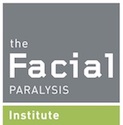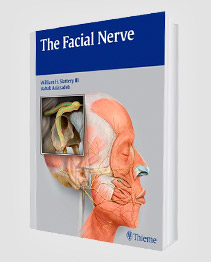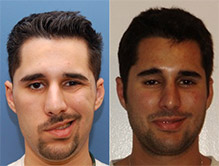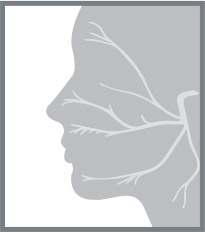The process to fix facial paralysis after acoustic neuroma tumor removal is rarely simple. By working with an expert facial plastic and reconstructive surgeon, an individual can alleviate facial paralysis symptoms after an acoustic neuroma is removed.
Acoustic neuroma facial paralysis sometimes occurs if a large tumor is present. Removing a large acoustic neuroma tumor requires significant care and attention. If the facial nerve is damaged – with surgery or radiation – during acoustic neuroma removal, a patient may experience post-treatment facial paralysis symptoms. Fortunately, treatment options are available to fix facial paralysis after acoustic neuroma tumor removal, and these options include:
1. Reconstructive Surgery
An acoustic neuroma patient may need to wait up to one year after treatment to pursue reconstructive surgery to fix his or her facial paralysis symptoms. If a facial plastic and reconstructive surgeon determines the facial nerve was damaged during acoustic neuroma removal, he or she may recommend facial reanimation surgery based on a patient’s health.
Oftentimes, direct nerve repair is the best option to treat facial paralysis following acoustic neuroma removal. It is performed at the site of acoustic neuroma removal and allows a surgeon to reattach the severed ends of the facial nerve. This helps improve facial nerve function.
An interposition graft may be used to address post-acoustic neuroma removal facial paralysis, too. The graft is obtained from a patient’s arm, leg or neck and is placed between two severed facial nerve ends.
In some cases, an acoustic neuroma patient’s facial nerve has suffered irreparable damage. This may require a surgeon to use one of the following techniques:
- Hypoglossal Facial Transfer: Involves the use of a graft of the hypoglossal facial nerve on the paralyzed side of a patient’s face.
- Masseteric Facial Transfer: Requires the facial nerve and masseteric nerve to be sewn together under microscopic magnification.
- Regional Muscle Transfer: Involves the attachment of the end of a muscle or tendon to the corner of a patient’s mouth.
- Free Muscle Transfer: Uses a muscle transplanted from a patient’s inner thigh or back to help restore a natural, dynamic smile.
- Static Procedures: Help reduce facial sagging; common static procedures include a brow lift, facelift and tendon or facial slings.
The ideal surgical treatment varies based on the acoustic neuroma patient and the severity of his or her facial paralysis symptoms. A surgeon performs a patient evaluation to determine if surgery can deliver the desired results. Then, he or she crafts a custom surgical treatment plan to accommodate a patient’s needs.
2. Botox
Botox is a non-surgical treatment for facial paralysis. It involves a series of injections to relax unwanted movements in the normal side of an acoustic neuroma patient’s face. This helps reduce tension in the face caused by hyperactive muscles.
The amount of Botox required during a treatment session varies from patient to patient. Meanwhile, the frequency of Botox injections varies based on the severity of an acoustic neuroma patient’s facial paralysis.
A facial plastic and reconstructive surgeon requests different tests to determine if an acoustic neuroma patient is a good candidate for Botox injections. These tests include an ear, nose and throat evaluation, neurologic assessment and vestibular test. In certain instances, a surgeon may recommend Botox be performed in combination with other treatments to help an acoustic neuroma patient correct his or her facial paralysis symptoms.
3. Facial Rehabilitation Therapy
Custom physical therapy sessions are sometimes required to fix facial paralysis after acoustic neuroma tumor removal. They teach a patient how to perform different exercises or manual massage techniques to improve facial muscle coordination.
Neuromuscular retraining (NMR) is one of the most common physical therapy techniques for facial paralysis. It involves the use of exercises that retrain the brain to coordinate facial muscle movements. In doing so, NMR helps acoustic neuroma patients suppress facial muscles that otherwise cause unwanted facial expressions.
Manual massage may be used to treat facial paralysis following acoustic neuroma tumor removal, too. It involves different massage techniques to reduce facial muscle tightness and improve flexibility. Manual massage techniques are generally performed by a physical therapist, but an acoustic neuroma patient can learn these techniques so he or she can perform them at home.
A physical therapy program is tailored to an acoustic neuroma patient’s facial paralysis symptoms. Specific exercises and massage techniques are incorporated into a patient’s physical therapy program. These exercises and massage techniques help a patient safely reduce his or her facial paralysis symptoms. Over time, the exercises and massage techniques improve a patient’s ability to produce natural facial expressions.
Schedule a Facial Paralysis Treatment Consultation with Dr. Azizzadeh Today
Dr. Babak Azizzadeh of The Facial Paralysis Institute is a globally recognized facial plastic and reconstructive surgeon with many years of industry experience. He takes a holistic approach to treat facial paralysis after acoustic neuroma removal to ensure his patient can overcome his or her facial paralysis symptoms.
Dr. Azizzadeh is happy to meet with a patient to discuss different facial paralysis treatment options. To schedule a consultation with Dr. Azizzadeh, please call us today at (310) 657-2203.
Request your consultation with Dr. Azizzadeh today
Call us at (310) 657-2203 to schedule an appointment.
Schedule a Consultation





